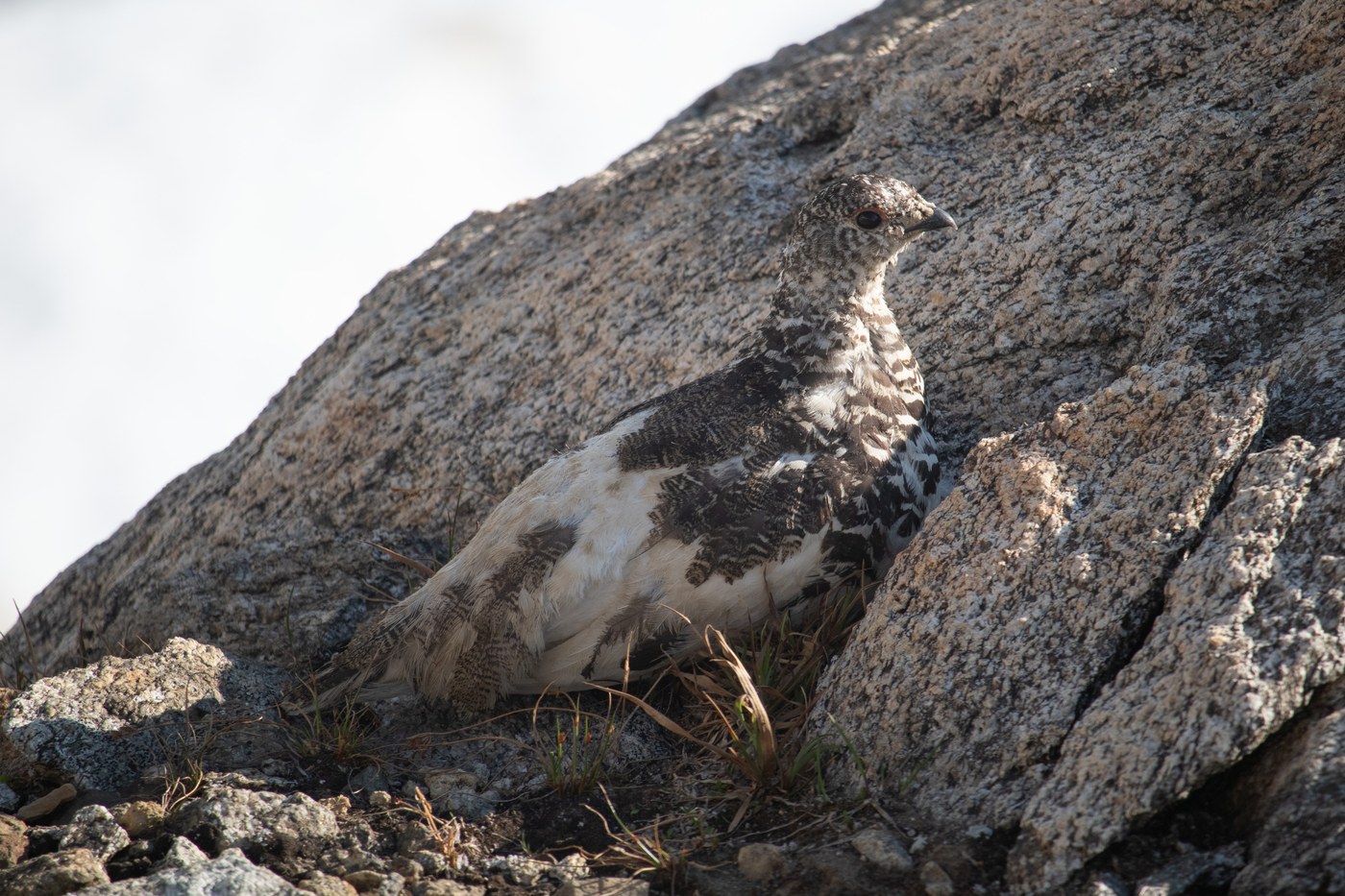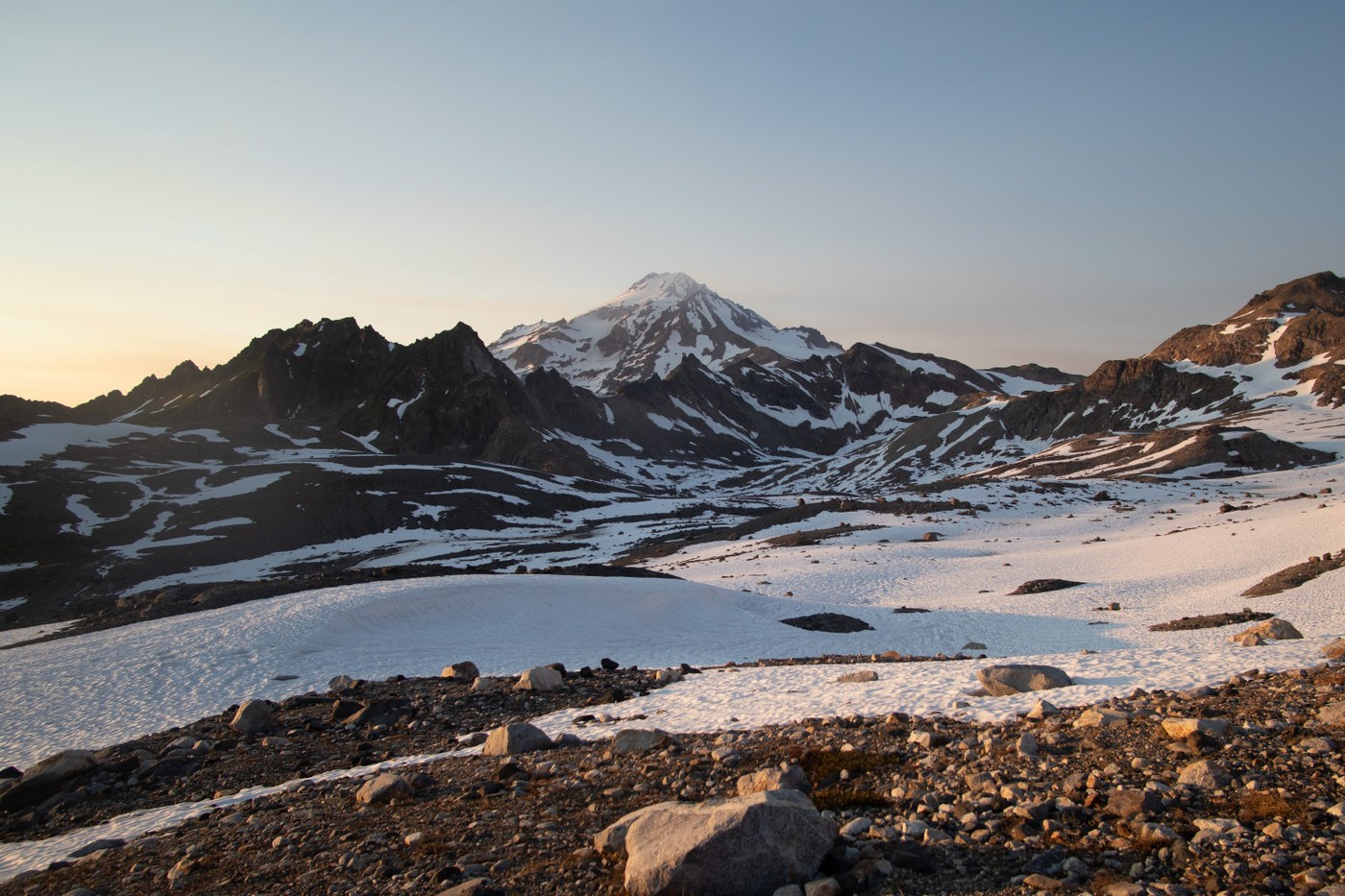I took a three-day trip up near Glacier Peak this week. This is the sixth year in a row that I’ve visited this area in summer, but I wanted to explore a bit more this year so I expanded the route into a loop of Pilot Ridge and Johnson Mountain which I’ve had an eye on for years.
I got a late start on Wednesday afternoon due to having to wait for some car work to be completed. I finally started out on the trail just before 5pm. I was thrilled to turn off the too-familiar N. Fork Sauk Trail after two miles and cross the river to ascend Pilot Ridge and experience something new. The log you cross is in decent shape and I had no issues crossing. The ascent up Pilot Ridge was pretty brutal. You gain 3000+ feet in 3 miles so an average of 20% grade. I was questioning my decision to run 8 miles that morning as my legs did not feel fresh. Once you complete this climb the trail becomes a bit more reasonable. The ridge looks pretty forested from what I’d seen, so I wasn’t sure what to expect view-wise, but things open up pretty nicely with great westward views. There was a bit of snow on the trail at the top of the first climb, but nothing that slowed me down too much.
With the light fading I continued along the ridge towards Johnson Mountain. I briefly got on the trail up to Johnson Mountain due to snow covering the fork, but thankfully my watch alerted me to the issue before I burned too much of the remaining daylight. I was a bit concerned about trying to find a campsite at Blue Lake, but thankfully there was a decent spot right next to the lake that had obviously only melted out days before. Unbeknownst to me I’d set up camp within a hundred feet of someone else whose tent was obscured by trees and I was a bit surprised when a headlamp popped on. I quickly set up my tent and got some much-needed rest.
I woke up before dawn and retraced my steps to ascend Johnson Mountain. Even with a backpack relieved of its heavier items the climb seemed a bit rough, but it was well worth it for the views. I descended, packed up camp and headed out over the pass to Bald Eagle Trail and eventually the PCT. The snow above Blue Lake was a bit worse than I’d seen thus far, but nothing too difficult to navigate.
The PCT to White Pass had a decent amount of snow covering, but again nothing concerning. I’d made a last-minute choice to leave my heavy microspikes in the car and nothing this week made me regret that choice. I’d done this section before, but over a month later in the year, so it was interesting to compare.
From a wildlife perspective the difference was surprisingly stark. In August there were quite a few birds moving around, but they were apparently mostly post-breeding dispersals and migrants. In July only breeding birds were present and they were sparse but quite vocal. The hoots of male Sooty Grouse were almost ubiquitous, as were Pine Siskins. Chipping Sparrows and Dark-eyed Junco’s frustrated me to no end with their identical songs. Lazuli Buntings are known to breed up at elevations this high, but always seem out of place compared to the habitat I find them in down at more reasonable elevations. Perhaps the most shocking find was the nearly complete absence of raptors. In August, Coopers and Sharped-shinned hawks have been a frequent site and I even photographed a young American Goshawk near Indian Head Peak in 2020. Golden Eagles, Red-tailed Hawks, and multiple species of falcons have also been frequent sights. On this clear day I don’t think I saw a single raptor.
At White Pass I veered east on the Foam Creek trail. This trail is well-used by climbers headed for Glacier Peak but had probably a dozen snow bridges over seasonal creeks that made traversal a bit sketchy. The final section, where you climb a short, steep pass to cross into the Glacier Peak Basin was completely snow covered and had no obvious best route so I elected to cross the snow and made my best push up over the top.
Once in the Glacier Peak Basin the snow arguably became a help more than a hinderance. On downhill and flat sections, it was a lot easier to traverse sloppy snow than the rocky terrain hidden below it. My usual campsites were all covered in snow and the few rocky sites that were exposed were unsuitable for a trekking pole tent. I finally found a suitable site towards the south side of the basin.
Once I had camp set up I wandered around in hopes of finding White-tailed Ptarmigan. I’d figured they’d be easier to find with snow covering up most of their habitat here, but that proved not to not be the case. In August and September, they’re often in vocal groups with a mom and young, but I’m guessing the mom’s are mostly on eggs right now. I did eventually stumble on to one bird that I’m assuming was from last-year’s brood based on plumage.
At some point I became aware that some Hoary Marmot’s were letting loose with a lot of alarm calls somewhere down the drainage towards White Mountain. I was aware from a trip report in late June that a Wolverine was in the area. I encountered two Wolverine’s here in 2018 and was hopeful that I might repeat that experience some day. I became suspicious of the source of the Marmot’s agitation and moved in that direction as quickly as I could given the terrain. After a long time of scanning, I finally spotted a Wolverine moving across the snowfield only a short distance from my 2018 sighting. I attempted to get closer to it but lost it as it apparently headed down the White-chuck drainage.
The next morning, I poked around the basin a bit before moving on. Once again, I was surprised to find birds a lot sparser than August, with a single Horned Lark the only new species for the trip and no more Ptarmigan seen. One unexpected highlight this early in the season were the American Pipits. In late summer this species is everywhere up here, and you get quite sick of looking at them hoping for something less common, but there were only a few up here at this time of year and they were still in breeding mode. In places with trees, singing males will typically find the highest perch and sing their hearts out, but species in habitats without trees are forced to make their own elevation. These American Pipits fly a hundred feet or more into the sky and sing their hearts out before finally descending back to the ground.
I woke up Friday morning to the sound of Ptarmigan “Scream” calls at first light. Once I finally willed myself out of my warm bed and out into the cold I was greeted by a Mountain Goat which had presumably come down to get a morning drink. I’ve seen what I presume are goat tracks on many occasions up here, but I’ve never actually seen a goat until this trip. I’m not sure where they hang out, but this one seemed to all but evaporate once I lost sight of it behind some rocks.
Glacier Peak had been shrouded in what looked suspiciously like smoke at sunset on Thursday, but when I woke Friday the smell of smoke was obvious. Thankfully it seemed to clear out throughout the day and didn’t impact the rest of my trip. After packing up I headed down to Glacier Peak Meadows, which is always a highlight of any trip to this area. The disappearance of this trail from official maps means it remains a tranquil spot even during the peak of the season, but I do lament that it’s missed by so many people. Based on snow crossings I appeared to be the first person to walk it this year. The snow continued to be a mixed blessing. My trail runners were wet, but I was able to replace some rocky, steep descents with glissading.
The fork of the White Chuck River that comes down from Red Pass was running much higher than when I usually come up here. I walked for some time hoping to find the right set of rocks to keep my feet dry, but finally gave up and just got my feet soaked. I hit the PCT and climbed up to Red Pass. The snow crossings in this area were the most annoying of the trip and post holing happened quite a bit. It was strange to be up here when it’s so deserted since in August it’s common to pass half a dozen or more NOBO section and through hikers on there way north.
At Red Pass I stashed my bag and went and tagged Portal Peak. The route was snow free all the way to the top and it was a nice vantage point to relive my day on the Painted Traverse last summer. I don’t know what the protocol is on peak registers, but this one continues to be in terrible shape. The notebook doesn’t quite fit back inside the pipe so the outer sheets get messed up every time it’s used and nothing from the last year or so was readable. It’d be nice to get a new notebook or maybe even a slightly larger pipe up there.
I’d intended on staying out one more night, but I needed to be back to pick my dog up from the kennel by noon and had accomplished everything I’d wanted to on this trip so I decided sleeping in my bed sounded better than setting up a tent and camping again. I meandered around the White Pass campground and ate my dinner next to a very unflappable Sooty Grouse before heading back towards the trailhead. I did my best to hustle and made it back to my car just before sunset.







Comments
Loren Drummond on Johnson Mountain, North Fork Sauk River, Pilot Ridge, Foam Creek Basin, Glacier Peak Meadows
WOW! It really is so pretty up there. Incredible that you spotted a wolverine (again!)
Posted by:
Loren Drummond on Jul 15, 2024 03:56 PM
marmot19 on Johnson Mountain, North Fork Sauk River, Pilot Ridge, Foam Creek Basin, Glacier Peak Meadows
Would you consider sending that photo of the wolverine to hello@cascadescarnivore.org ? They do research on wolverines.
Thanks for considering
Marmot19
Posted by:
marmot19 on Jul 18, 2024 08:21 AM